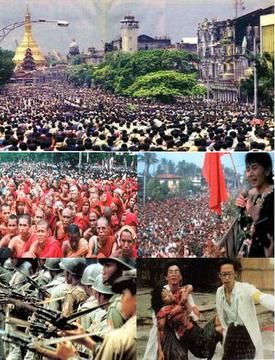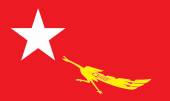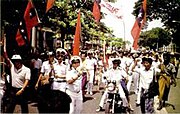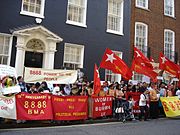8888 Uprising
| 8888 Uprising | |||
|---|---|---|---|

| |||
| Date | 12 March – 21 September 1988 (6 months, 1 week and 2 days) | ||
| Location | Burma (nationwide) | ||
| Caused by |
| ||
| Goals | Multi-party democracy in Burma and the resignation of Ne Win | ||
| Methods |
| ||
| Resulted in | Military coup d'état on 18 September 1988; demonstrations suppressed by force | ||
| Concessions |
| ||
| Parties | |||
| |||
| Lead figures | |||
| Number | |||
| |||
| Casualties | |||
| Death(s) | 350 (official count) 3,000[4]–10,000[5][6] (estimates) | ||
| Injuries | Unknown | ||
| Arrested | Unknown | ||
The 8888 Uprising,
Since 1962, the
The 8888 uprising was started by students in
During the crisis,
Background
| Part of a series on the |
| Democracy movements in Myanmar |
|---|
 |
| Background |
|
|
| Mass protests |
| Development |
| Elections |
| Organizations |
| Figures |
| Related topics |
Economic problems
Before the crisis,
1985 and 1987 demonetisation crises
In the years leading up to the crisis, General Ne Win had imposed two instances of sudden
On 5 September 1987, Ne Win announced the demonetisation of the 25, 35, and 75 kyat notes, leaving only the 1, 5, and 10 kyat bills valid.[26] This announcement was also with no prior warning, and this time no exchange for valid tender was allowed. Roughly 60–80% of circulated legal tender was declared invalid without warning, and millions of Burmese citizens had their savings eliminated by this action.[24] On 22 September 1987, the Burmese government introduced new denominations of 45 and 90 kyat notes. The 45 and 90 kyat denominations were chosen because the two numbers are divisible by 9, which was considered lucky by Ne Win.[27]
Students in particular were angry at the 1987 demonetisation as savings for tuition fees were wiped out instantly.
Early democracy protests
After receiving
On 12 March 1988, students from the
By mid-March, several protests had occurred and there was open dissent in the army. Various demonstrations were broken up by using tear gas canisters to disperse crowds.[27] On 16 March, students demanding an end to one party rule marched towards soldiers at Inya Lake when riot police stormed from the rear, clubbing several students to death and raping others.[36] Several students recalled the police shouting, "Don't let them escape" and "Kill them!".[37]
Ne Win resigns
Following the latest protests, authorities announced the closure of universities for several months.
Main protests
1–7 August

Protests reached their peak in August 1988. Students planned for a nationwide demonstration on 8 August 1988, an auspicious date based on numerological significance.
In the first few days of the Rangoon protests, activists contacted
8–12 August
Across Burma, people poured out in thousands to join the protests – not just students but also teachers, monks, children, professionals, and trade unionists of every shade. It was on this day, too, that the junta made its first determined attempt at repression. Soldiers opened fire on the demonstrators and hundreds of unarmed marchers were killed. The killings continued for a week, but still the demonstrators continued to flood the streets.
— Amitav Ghosh (2001)[45][page needed]
A general strike, as planned, began on 8 August 1988. Mass demonstrations were held across Burma as ethnic minorities,
In
A short while later, the authorities opened fire on the protesters.
Estimates of the number of casualties surrounding the 8-8-88 demonstrations range from hundreds to 10,000;[5][4][6] military authorities put the figures at about 95 people killed and 240 wounded.[52]
13–31 August
Lwin's sudden and unexplained resignation on 12 August left many protestors confused and jubilant. Security forces exercised greater caution with demonstrators, particularly in neighbourhoods that were entirely controlled by demonstrators and committees.[48] On 19 August, under pressure to form a civilian government, Ne Win's biographer, Dr. Maung Maung, was appointed as head of government.[53][page needed] Maung was a legal scholar and the only non-military individual to serve in the Burma Socialist Programme Party(BSPP).[3] The appointment of Maung briefly resulted in a subsidence of the shooting and protests.
Nationwide demonstrations resumed on 22 August 1988. In Mandalay, 100,000 people protested, including Buddhist monks and 50,000 demonstrated in
On 26 August,
Around this time, former Prime Minister U Nu and retired Brigadier General Aung Gyi also re-emerged onto the political scene in what was described as a "democracy summer" when many former democracy leaders returned.[39] Despite the gains made by the democracy movement, Ne Win remained in the background.
September
During the September congress of 1988, 90% of party delegates (968 out of 1080) voted for a multi-party system of government.
By mid-September, the protests grew more violent and lawless, with soldiers deliberately leading protesters into skirmishes that the army easily won.[65] Protesters demanded more immediate change, and distrusted steps for incremental reform.[66][page needed]
SLORC coup and crackdown
| Date | 18 September 1988 |
|---|---|
| Location | State Law and Order Restoration Council (SLORC)
|
If the military shoots, it has no tradition of shooting into the air. It shoots straight to kill.
On 18 September 1988, the military retook power in the country. General
Although an exact body count has not been determined as bodies were often cremated, it is estimated[
"I would like every country in the world to recognize the fact that the people of Burma are being shot down for no reason at all."
— Aung San Suu Kyi, 22 September 1988[61]
By the end of September, there were around 3,000 estimated deaths and unknown number of injured,[65] with 1,000 deaths in Rangoon alone.[71] At this point in time, Aung San Suu Kyi appealed for help.[61] On 21 September, the government had regained control of the country,[71] with the movement effectively collapsing in October.[61] By the end of 1988, it was estimated[by whom?] that 10,000 people, including protesters and soldiers, had been killed.[6][page needed]
Aftermath
Many in Burma believed that the regime would have collapsed if the United Nations and neighbouring countries had refused to recognise the legitimacy of the coup.
After the uprising, the SLORC waged a "clumsy propaganda" campaign against those who had organised the protests.
Between 1988 and 2000, the Burmese government established 20 museums which detailed the military's central role throughout
Significance
Today, the uprising is commemorated by Burmese expatriates and citizens. In Thailand, students also commemorate the uprising every 8 August.[82] On the 20th anniversary of the uprising, 48 activists were arrested for commemorating the event in Burma.[83] The event garnered much support for the Burmese people internationally. Poems were written by students who participated in the protests. The 1995 film Beyond Rangoon is a fictionalized drama which is based on the events that took place during the uprising.
The uprising led to the death and imprisonment of thousands of individuals. Many of the deaths occurred inside the prisons, where prisoners of conscience were subjected to inhumane torture and deprived of basic provisions, such as food, water, medicine, and sanitation. From 1988 to 2012, the military and the police illegally detained and imprisoned tens of thousands of leaders of the Burmese pro-democracy movement, as well as
Many of the student leaders of the uprising became lifelong human rights activists and leaders of the Burmese pro-democracy movement. Nineteen years later, many of these same activists also played a role in the
Gallery
-
Burma Navy personnel demonstrating
-
Demonstration held on the 19th anniversary of the 8888 Uprising
See also
Notes
References
- ^ "Talk to Doctor from 8888 historical picture - Part 1". YouTube. Archived from the original on 8 February 2022. Retrieved 8 February 2022.
- ]
- ^ a b c d e f g Fong (2008), pp. 149
- ^ a b c Fogarty, Phillipa (7 August 2008). Was Burma's 1988 uprising worth it? Archived 12 January 2009 at the Wayback Machine. BBC News.
- ^ a b c d e Ferrara (2003), pp. 313
- ^ a b c d Wintle (2007)
- ^ a b c Yawnghwe (1995), pp. 170
- ^ Head, Jonathan (16 March 2021). "Myanmar coup: What protesters can learn from the '1988 generation'". BBC News. Archived from the original on 17 May 2021. Retrieved 17 May 2021.
- ^ Ferrara (2003), pp. 302–303
- ^ "Hunger for food, leadership sparked Burma riots". Houston Chronicle. 11 August 1988.
- ^ Tweedie, Penny. (2008). Junta oppression remembered Archived 2 May 2011 at the Wayback Machine. Reuters.
- ^ a b Burma Watcher (1989)
- ^ *Tallentire, Mark (28 September 2007). The Burma road to ruin Archived 4 March 2016 at the Wayback Machine. The Guardian.
- ^ a b Woodsome, Kate. (7 October 2007). 'Burmese Way to Socialism' Drives Country into Poverty. Voice of America.
- ^ a b Steinberg (2002)
- ^ Aung-Thwin, Maureen. (1989). Burmese Days Archived 23 February 2006 at the Wayback Machine. Foreign Affairs.
- ^ Ottawa Citizen. 24 September 1988. pg. A.16
- ^ Associated Press. Chicago Tribune. 26 September 1988.
- ^ Wintle, p. 338.
- ^ "'A dangerous time' in Myanmar: Burmese in California struggle for answers, attention". Los Angeles Times. 3 June 2021. Archived from the original on 18 September 2021. Retrieved 19 September 2021.
- ^ "[Interview] Myanmar democracy leader in S. Korea is "100% certain that this democratization movement will succeed"". english.hani.co.kr. Archived from the original on 17 September 2021. Retrieved 19 September 2021.
- ^ "Myanmar coup: What protesters can learn from the '1988 generation'". BBC News. 16 March 2021. Archived from the original on 26 September 2021. Retrieved 19 September 2021.
- ^ Lintner (1989), pp. 94–95.
- ^ a b c d Karthikeyan, Ananth (28 October 2017). "A Ne Win Situation: Burma's three demonetizations". Mint. Archived from the original on 4 June 2021. Retrieved 28 May 2021.
- ^ a b Boudreau (2004), pp. 192
- ^ Williams, Nick B. Jr. (12 September 1987). "Commerce Snarled as Burma Rules Much of Its Currency Is Worthless". Archived from the original on 4 June 2021. Retrieved 28 May 2021.
- ^ a b c d e f g h Tucker (2001), pp. 228
- ^ Fong (2008), pp. 146
- ^ Lwin (1992)
- ^ a b c d e f g Boudreau (2004), pp. 193
- ^ Lintner (1989), pp. 95–97.
- ^ Yitri (1989)
- ^ a b c d Yawnghwe (1995), pp. 171
- ^ Fong (2008), pp. 147
- ^ Smith (1999), pp. 1–14
- ^ Fong (2008) pp. 147–148.
- ^ Fink (2001), pp. 51
- ^ a b c Fong (2008), pp. 148
- ^ a b Smith (1999)
- ^ Fong (2008). In 1962, Lwin had ordered troops to fire on student protestors, killing dozens, and ordered the Union Building at Rangoon University to be blown up.
- ^ a b Boudreau (2004), pp. 202
- ^ Lintner (1989), pp. 126
- ^ Boudreau (2004) Two groups considered to have large underground and internal support networks
- ^ a b c d Boudreau (2004), pp. 203
- ^ a b c Ghosh (2001)
- ^ a b c Mydans, Seth. (12 August 1988). Uprising in Burma: The Old Regime Under Siege. The New York Times.
- ^ Williams Jr., Nick. (10 August 1988). "36 Killed in Burma Protests of Military Rule." Los Angeles Times.
- ^ a b c Boudreau (2004), pp. 205
- ^ Callahan (2001)
- ^ a b Boudreau (2004), pp. 204
- ^ a b Burma Watcher (1989), pp. 179.
- ^ The Vancouver Sun 17 August 1988. pg. A.5
- ^ Fink (2001)
- ^ Fink (2001), pp. 58
- ^ a b c d Fong (2008), pp. 150
- ^ a b Boudreau (2004), pp. 208
- ^ Clements (1992)
- ^ Smith (1999), pp. 9
- ^ Silverstein (1996)
- ^ Fink (2001), pp. 60
- ^ a b c d e f Tucker (2001), pp. 229.
- ^ Boudreau (2004), pp. 212.
- ^ Callahan (1999), pp. 1.
- ^ United States State Department, 1988
- ^ a b c Boudreau (2004), pp. 210.
- ^ Maung (1999)
- ^ Yeni. "Twenty Years of Marking Time". The Irrawaddy. Archived from the original on 19 January 2012. Retrieved 20 November 2011.
- ^ Kyi May Kaung (8 August 2008). "Burma: waiting for the dawn". Open Democracy. Archived from the original on 15 January 2012. Retrieved 21 November 2011.
- ^ Delang (2000)
- ^ Ferrara (2003), pp. 313–4.
- ^ a b c Ferrara (2003), pp. 314.
- ^ a b c Fong (2008), pp. 151
- ^ Yawnghwe (1995), pp. 172.
- ^ Europa Publications Staff (2002), pp. 872
- ^ Fong (2008), pp.152.
- ^ Smith (1999), pp. 371.
- ^ Smith (1999), pp. 17.
- ^ a b c d Boudreau (2004), pp. 190
- ^ a b Lintner (1990), pp. 52
- ^ Mydans, Seth. (23 September 1988). Burma Crackdown: Army in Charge. The New York Times.
- ^ Thein, Seinenu (May 2014). "Heroes of Democracy: Burma's 88 Generation and the Legacy of Mandela". Psychocultural Cinema. Archived from the original on 19 July 2016. Retrieved 15 June 2016.
- ^ The Nation. (9 August 1997). Burmese exiles mark protest. The Nation (Thailand).
- ^ *Tun, Aung Hla. (8 August 2008). Myanmar arrests "8-8-88" anniversary marchers Archived 8 January 2009 at the Wayback Machine. International Herald Tribune.
- ^ Moe, K Z (21 January 2012). "The last night in the cell". The Irrawaddy. Archived from the original on 7 August 2016. Retrieved 30 May 2016.
- ^ Jonathan Head (11 November 2008). "Harsh sentences for Burma rebels". BBC News. Archived from the original on 11 May 2011. Retrieved 17 April 2011.
- ^ "A former political prisoner was arrested for protesting alone in front of the United Nations office in Rangoon". Assistance Association for Political Prisoners. 23 September 2004. Archived from the original on 2 June 2011. Retrieved 15 May 2011.
Bibliography
Books and journals
- Boudreau, Vincent. (2004). Resisting Dictatorship: Repression and Protest in Southeast Asia. Cambridge University Press. ISBN 978-0-521-83989-1.
- Burma Watcher. (1989). Burma in 1988: There Came a Whirlwind. Asian Survey, 29(2). A Survey of Asia in 1988: Part II pp. 174–180.
- Callahan, Mary. (1999). Civil-military relations in Burma: Soldiers as state-builders in the postcolonial era. Preparation for the State and the Soldier in Asia Conference.
- Callahan, Mary. (2001). Burma: Soldiers as State Builders. ch. 17. cited in Alagappa, Muthiah. (2001). Coercion and Governance: The Declining Political Role of the Military in Asia. Stanford University Press. ISBN 978-0-8047-4227-6
- Clements, Ann. (1992). Burma: The Next Killing Fields? Odonian Press. ISBN 978-1-878825-21-6
- Delang, Claudio. (2000). Suffering in Silence, the Human Rights Nightmare of the Karen People of Burma. Parkland: Universal Press.
- Europa Publications Staff. (2002). The Far East and Australasia 2003. ISBN 978-1-85743-133-9.
- Ferrara, Federico. (2003). Why Regimes Create Disorder: Hobbes's Dilemma during a Rangoon Summer. The Journal of Conflict Resolution, 47(3), pp. 302–325.
- Fink, Christina. (2001). Living Silence: Burma Under Military Rule. Zed Books. ISBN 978-1-85649-926-2
- Fong, Jack. (2008). Revolution as Development: The Karen Self-determination Struggle Against Ethnocracy (1949–2004). Boca Raton, FL:BrownWalker Press. ISBN 978-1-59942-994-6
- Ghosh, Amitav. (2001). The Kenyon Review, New Series. Cultures of Creativity: The Centennial Celebration of the Nobel Prizes. 23(2), pp. 158–165.
- Hlaing, Kyaw Yin. (1996). Skirting the regime's rules.
- Lintner, Bertil. (1989). Outrage: Burma's Struggle for Democracy. Hong Kong: Review Publishing Co.
- Lintner, Bertil. (1990). The Rise and Fall of the Communist Party of Burma (CPB). SEAP Publications. ISBN 978-0-87727-123-9.
- Lwin, Nyi Nyi. (1992). Refugee Student Interviews. A Burma-India Situation Report.
- Maung, Maung. (1999). The 1988 Uprising in Burma. Yale University Southeast Asia Studies. ISBN 978-0-938692-71-3
- Silverstein, Josef. (1996). The Idea of Freedom in Burma and the Political Thought of Daw Aung San Suu Kyi. Pacific Affairs, 69(2), pp. 211–228.
- Smith, Martin. (1999). Burma – Insurgency and the Politics of Ethnicity. Zed Books. ISBN 978-1-85649-660-5
- Steinberg, David. (2002). Burma: State of Myanmar. Georgetown University Press. ISBN 978-0-87840-893-1
- Tucker, Shelby. (2001). Burma: The Curse of Independence. Pluto Press. ISBN 978-0-7453-1541-6
- Wintle, Justin. (2007). Perfect Hostage: a life of Aung San Suu Kyi, Burma's prisoner of conscience. New York: Skyhorse Publishing. ISBN 978-0-09-179681-5
- Yawnghwe, Chao-Tzang. Burma: Depoliticization of the Political. cited in Alagappa, Muthiah. (1995). Political Legitimacy in Southeast Asia: The Quest for Moral Authority. Stanford University Press. ISBN 978-0-8047-2560-6
- Yitri, Moksha. (1989). The Crisis in Burma: Back from the Heart of Darkness? University of California Press.
Further reading
- AP. (1988). Burma Imposes Martial Law In the Capital After a Protest Archived 14 July 2018 at the Wayback Machine, The New York Times, 4 August 1988.
- AP. (1988). Road To Upheaval In Politics For Burmese Archived 14 July 2018 at the Wayback Machine, The New York Times, 11 September 1988.
- Cumming-Bruce, Nick. (1988). Burma's new leader imposes martial law Archived 14 April 2016 at the Wayback Machine, The Guardian, 4 August 1988.
- Faulder, Dominic. (2008). Memories of 8 August 1988 The Irrawaddy, August 2008.
- Kamm, Henry. (1988). Tension Reported High In Burma After Clashes Archived 14 July 2018 at the Wayback Machine, The New York Times, 2 July 1988.
- Mydans, Seth. (1988). A Burmese Power Shift; Though Government Schedules Election, Decision Rests With People in the Streets Archived 10 November 2012 at the Wayback Machine, The New York Times, 12 September 1988.
- Mydans, Seth. (1988). Defections Strain Burmese Military Archived 14 July 2018 at the Wayback Machine, The New York Times, 10 September 1988.
- Mydans, Seth. (1988). Many in Burma Say Ne Win Continues to Pull the Strings Archived 14 July 2018 at the Wayback Machine, The New York Times, 13 September 1988.
- Richburg, Keith. (1988). Youths, Monks Fight Troops in Burma; Post-Coup Deaths Reported in Hundreds. Washington Post, 20 September 1988.
- Stewart, William. (1988). Burma The Armed Forces Seize Power, TIME, 26 September 1988.
- Protests mark Burma anniversary Archived 16 October 2007 at the Wayback Machine, BBC News, 8 August 2003.
- Burma's 1988 Protests Archived 11 May 2011 at the Wayback Machine, BBC News, 25 September 2007.
- Partial list of 8888 Uprising victims, The Irrawaddy, 1 January 2003.


